By Jack D. Young, Early American Coppers (EAC) ……
Continuing on the theme of deceptive struck counterfeits, this is likely my most ambitious research article since my CoinWeek piece on the counterfeit 1798 “S-158” large cents, the coin and variety that lead a group of fellow enthusiasts and myself down the path of hunting for more! And just over five years and 26 different denominations/varieties later, I will focus on another early large cent in a summary article, hoping to hear from readers their reactions to the information and thoughts presented here.
This may also be my most controversial, with opinions on the subject example reaching both sides of the discussion.
In the initial research back in late 2015, our group gathered and reviewed many images of suspect “coins” – including an example of a 1797 S-139 large cent submitted for authentication to one of the major TPGs. This image follows:
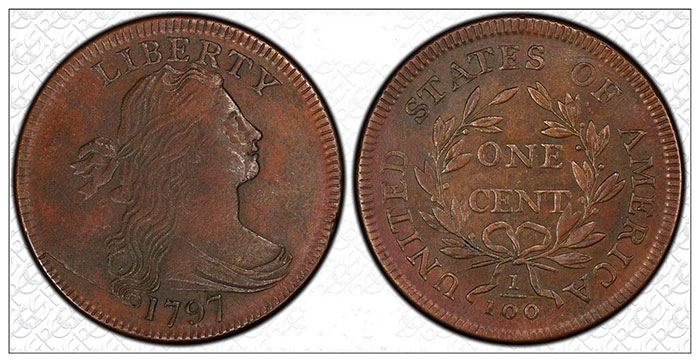
When reviewing a subject coin we always take note of any significant marks and or scratches, etc., that can be used to identify it, as well as other similar examples we can dig up through our searches.
One thing I noted is that there are some light scratches on the portrait and nicks on the neck of this example.

Through repetition, I developed and refined my evaluation “process” as follows. It is an extensive and time-consuming process, and one that I assume would be difficult for the TPGs to follow under their probable time constraints.
The Jack Young Process for Evaluating “Suspicious” Early Copper (Or any other Suspicious Coin)
-
- Using the best images available, review the subject example by ATTRIBUTING it.
- Detail grade the subject example (for early copper, refer to EAC Grading Guide).
- Evaluate any relative differences to images of many known genuine examples from the internet, guide books, etc. Have overlays to a known genuine example run for comparison.
- Search for any additional examples with any matching “sister marks” on coin marketplaces and auction sites online, as well as TPG sites and listed certs.
- Take dimensional measurements for examples available “in-hand” and compare these to existing data. XRF measurements should be taken if possible.
- Record notes about appearance and the edge- any significant impressions you have regarding “appearance”.
- Have high-resolution images taken, including the edge, when it is feasible to do so. If not, use the best images available.
- Review with “Dark Side” Team, and other Experts for additional insights on the “suspicious” subject example (may be interjected at any point in the process depending on availability of data for the current subject example).
- Create a timeline of all matching examples to help identify possible duplications as applicable.
- Generate a “best guess” of authenticity based on all of the data.
- Summarize results and supporting data/images into a draft for review.
From this initial image review, as well as information we were gathering on a list of suspicious characters known through a popular internet selling venue, we found images of a similar specimen, an apparent repaired example in a TPG slab.
The image is low resolution but appears to show an area of tooling or repair on the obverse (the obvious discolored area); the TPG slab notes “Scratched” on the label.
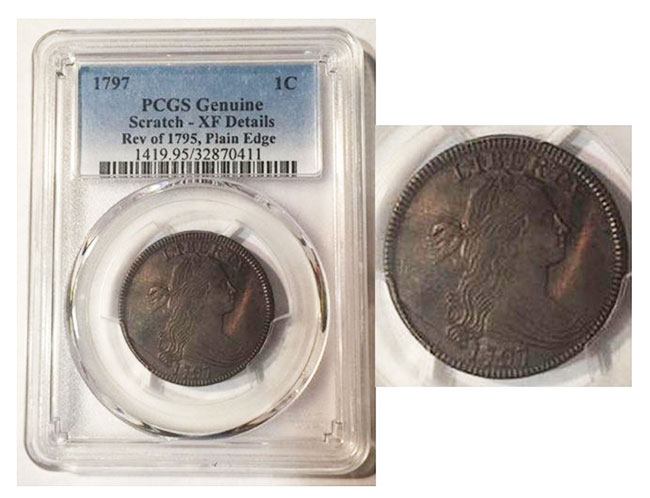
Just a side note, this example was reviewed with the TPG and the cert was made inactive.
And as luck would have it we found a second raw example roughly one year after the first images were reviewed, from an internet seller “connected” to the seller of the “scratched” example:
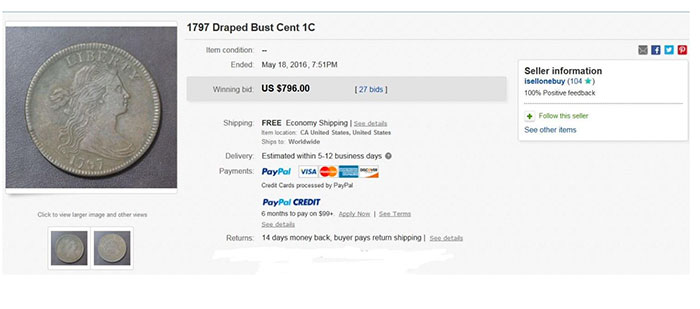
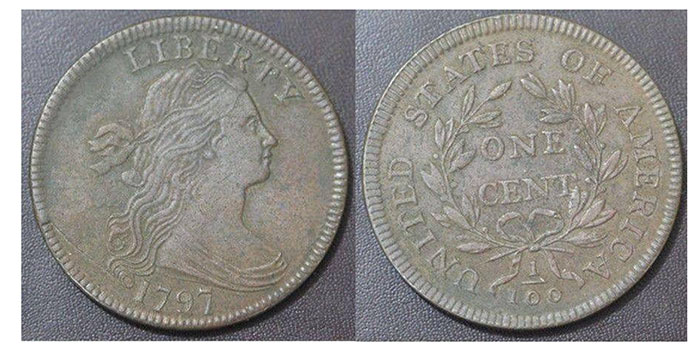
This one went silent for quite a while until it turned up again in the same selling venue in 2018.
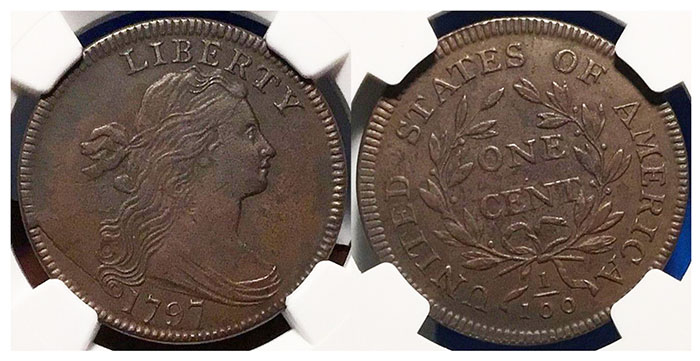
The buyer is known to me and is now a member of a group I am in; the coin was submitted to a TPG and certified “AU Details Environmental Damage” but cracked out for resale.
This placed my focus back on this “variety”, and continued internet searching uncovered the probable genuine source example from a 2013 Goldberg coin auction.
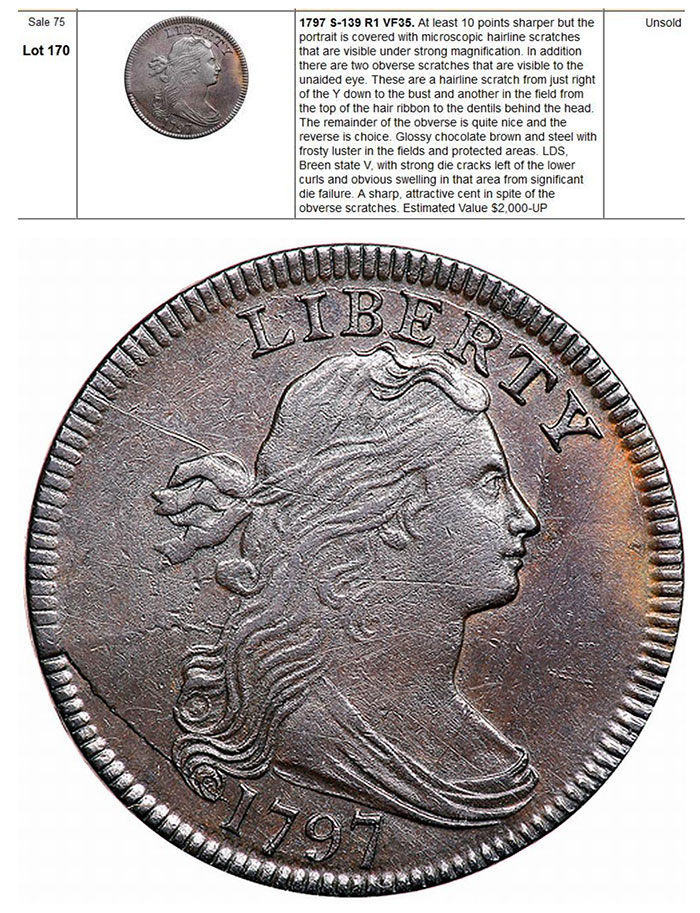
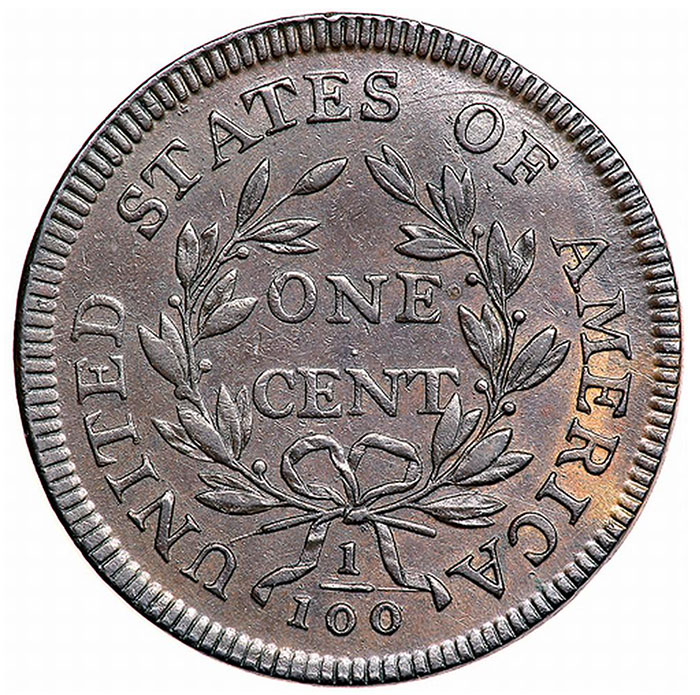
Like finding the mother lode, these images allowed us to see all of the scratches and marks that should be unique to this example and compare these identifiers (“sister marks”) to other suspect ones!
Images were reviewed in several different Groups and Forums and several of the main sister marks appeared to match, signifying a probable counterfeit. I coordinated having better images to continue the review.
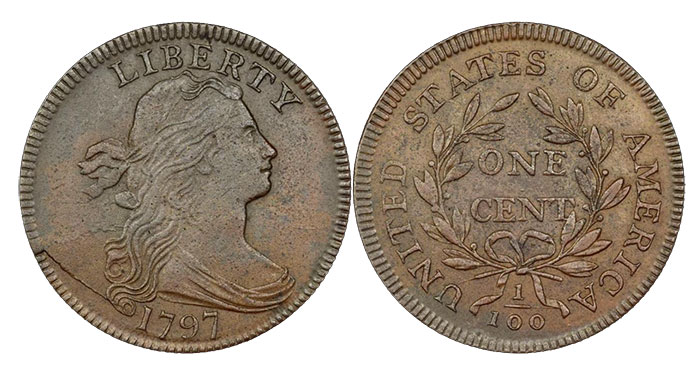
Comparison images enhanced the matching marks between not only these two but also the initial 2015 TPG-submitted example, and there are enough unique marks to indicate they are different examples. Certainly at least one is a counterfeit!
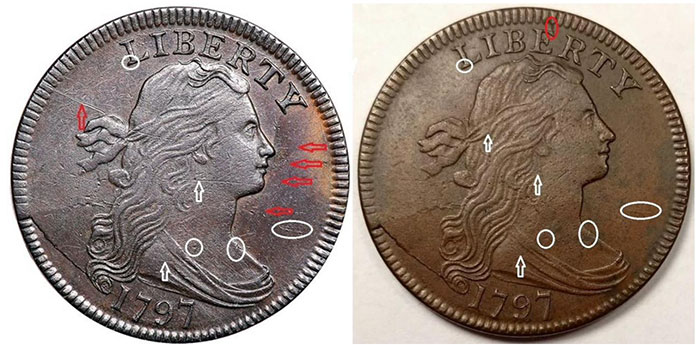
The main scratch in the right obverse field does not show on the 2018 example on the right, in the same area where the PCGS Genuine Scratched example is discolored, likely from the work to smooth/ remove it prior to making the counterfeit dies…
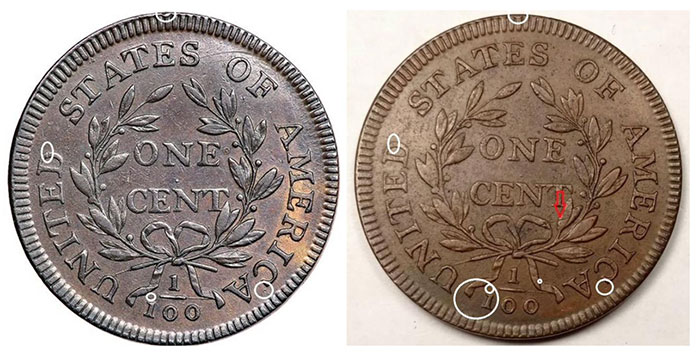
There is a unique scratch on the 2018 example on the right that is not apparent on either the source example or the 2015 submitted example, distinguishing them from each other.
Other differences of note between these two are the subtle die cracks over LIBERTY” on the obverse and the die clash at OF on the reverse. The probable source coin has them; the subject coin, not so much.

Maybe lost in the “process” to make the die, we have seen die cracks removed in other counterfeit varieties like the 1798 “S-158”.
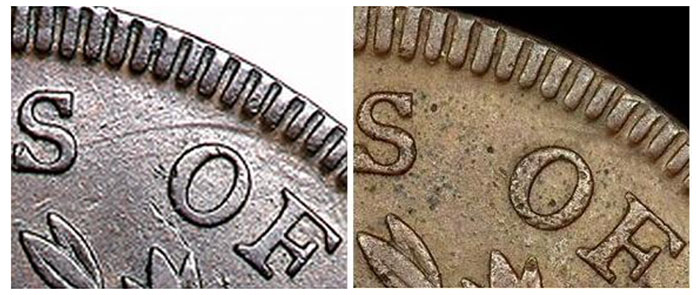
A quick comparison of this probable source example and the possible repaired source coin as follows:
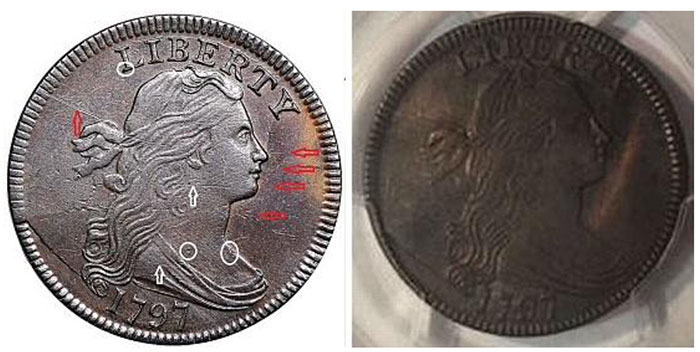
The discolored/repaired area on the certified example on the right appears to match the scratched area on the example on the left.
One of the steps in my evaluation process is to compare the subject example(s) with images of known genuine ones. To this end, I posted images of these in another forum I participate in and a member there used his CAD (Computer Aided Design) software to create the excellent maps and overlays that follow. I have also quoted his poignant summary of the results.
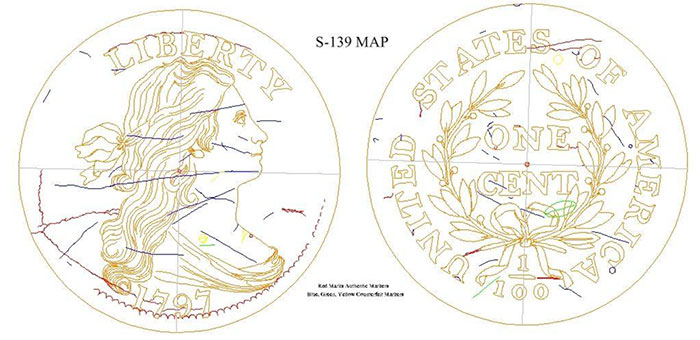
“The marks in red are those characteristics that appear to be common to the three PCGS authentic examples and the proposed source coin (which is also an authentic example of S-139). What makes the source coin unique in this situation is that it is the coin believed to be the example used as the model from which the counterfeit dies were created. The red marks are those I propose are characteristics of the authentic S-139 obverse and reverse dies.
“Therefore characteristics transferred to authentic coins struck at the same die stage and state. Scratches, gouges, and clashes of a die can occur at any time during coin production. But they exhibit strongest on coinage when first occurred and tend to fade over time. Anyway, an authentic coin of the same die state and stage should exhibit those characteristics I have indicated in red.
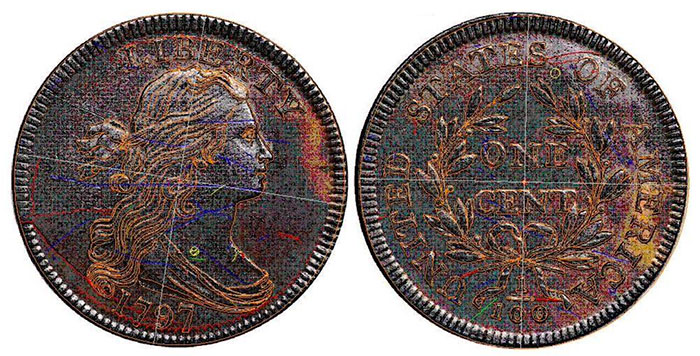
“The marks in blue are characteristics (gouges, scratches, etc.) of the source coin that are common to the counterfeit coins but are not a characteristic exhibited by the three authentic PCGS examples. I propose these characteristics were transferred to the counterfeit dies when modeled and created from the source coin. Any coin exhibiting these blue markers is a suspect counterfeit. The marks in green are characteristics that appear to be common to the counterfeit coins but do not appear to be characteristics of the source coin.


“Any coin exhibiting these green markers is a suspect counterfeit. The yellow marks are counterfeit die markers indicated by Jack in the OP that although were common to some; I couldn’t verify, due to the images provided, to be common to all the counterfeit coins. Any coin exhibiting these yellow characteristics is a suspect counterfeit. This is not to say an authentic coin couldn’t exhibit some similar characteristics as the counterfeits.”
One of the highlighted marks from this exercise that I hadn’t considered is the reverse scratch left of the fraction. Not as visible in all of the images, it appears as a slight dig at the start on the source coin image but is also visible on the two suspect coins at this point of the research.
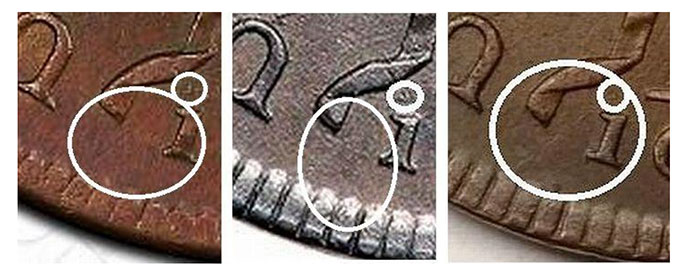
As I have done in all of my research summaries and as a step in my evaluation process, it is important to develop a time-line of the documented examples to help understand the possible “age” of these – as well as try to distinguish (with unique marks as well) how many different examples we have captured in the study.
Timeline for the 1797 “S-139” Large Cent
- September 2013: Golberg auction- probable source coin.
- Fall 2015: TPG submitted example- deemed counterfeit by TPG.
- 2016: Internet listing of known bad seller example- possible repaired source coin.
- March 2016: Internet listing of example connected to bad seller example- too damaged to make a definite determination.
- May 2016: Internet listing of example connected to bad seller example- subject coin (raw)
- October 2018: Internet listing of TPG-certified example is listed for sale- same coin as #5.
Example #4 was listed by a known seller of counterfeits linked to other bad sellers in the internet selling venue; he listed it as having “Serious decay”, which was an understatement. It certainly matches the variety and die state of the others but is too corroded and the images too poor for positive identification.
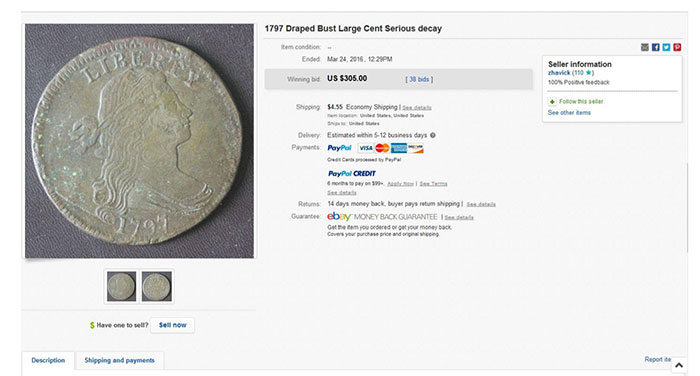
It is admittedly difficult to positively identify a specific coin as counterfeit without having seen it “in hand”. As in my other articles, when several examples all have the same circulation marks one can be sure that at least all but one (the genuine source coin) are fakes (or, as I often say, struck clones).
Reviewing just the image of the subject coin within early American copper enthusiasts (including EAC members), the coin appears as a genuine higher-grade example and if genuine is considered then it is tied for #16 in the expanded Condition Census of Early Large Cents, graded XF-40, net VF-30 average.
After considerable discussions with the images presented here, I purchased the coin for further review not only by myself in hand but also by friends with much more experience in the early American copper field.
The coin, as well as the images of the proposed genuine damaged example (#1), was examined by several experienced EAC experts, including J. R. (Bob) Grellman, and the “coin” received the following grading card (image courtesy NGC and edge image courtesy the author):
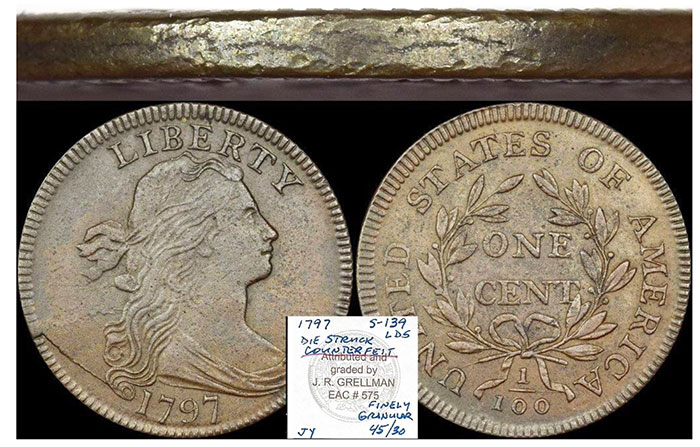
Since the original TPG grade, this example has been to two other TPGs for “certification”; the ICG image is as follows:

1797 S-139 Cent Counterfeit Attribution 1-Sheet Guide
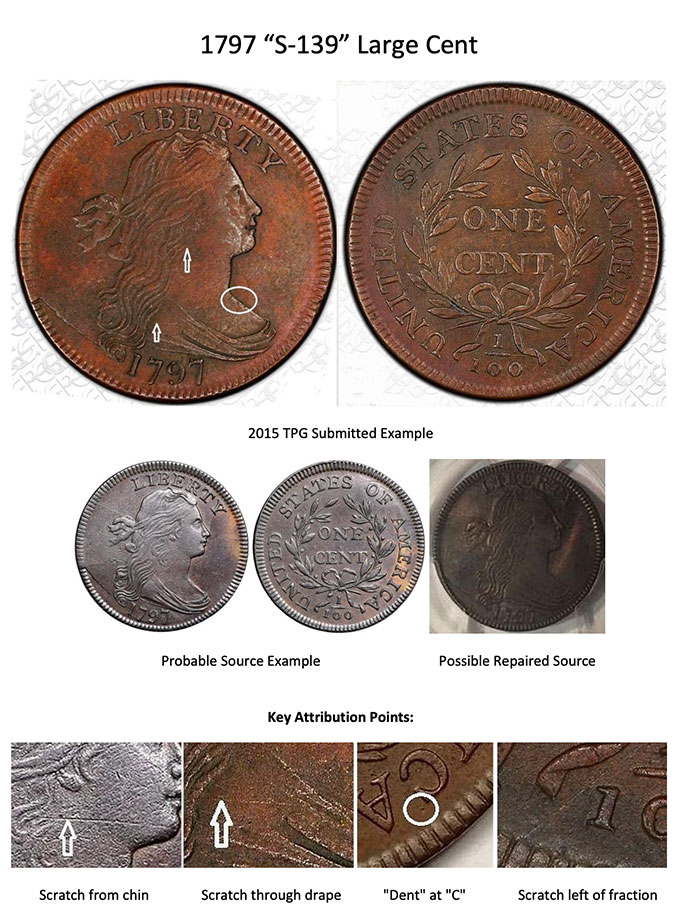
The subject example #6 currently resides in another TPG holder seen as Authentic, Environmental Damage-XF Detail.
And the question continues, “Live or Memorex”? I am of the opinion it is definitely a struck counterfeit.
With the help of a lot of friends, the research continues.
Read More Articles on Counterfeits by Jack D. Young Here !





I sold all of my large cents years ago, with the exception of a 1799 large cent which has a circle cut into, and a V shape cut on the edge.l held on to this coin due the possible historical association with Africa. How can I learn more about it?